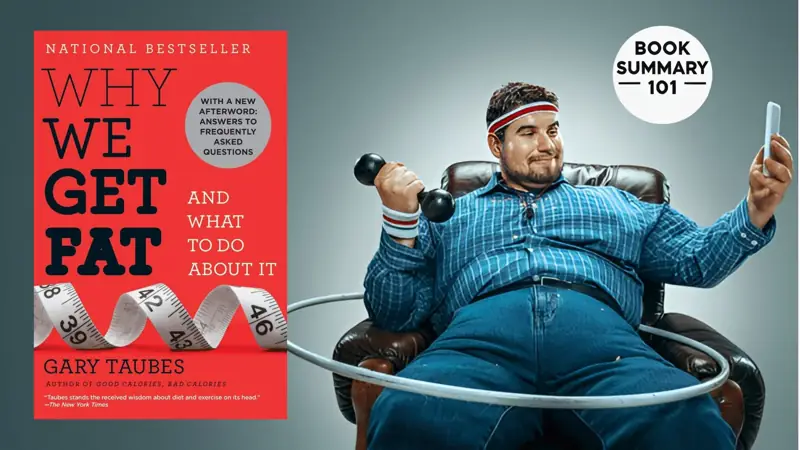Ever feel like you’re doing everything right – eating “healthy” foods, cutting calories, working out – but the weight just doesn’t seem to come off? Or maybe it does, but then stubbornly comes back? Gary Taubes’ book Why We Get Fat and What to Do About It delves deep into why weight gain is so challenging to control and how we might be approaching the issue all wrong.
Taubes takes a critical look at popular beliefs around diet and weight loss, questioning some of the long-held assumptions that have shaped how we think about food and health. He doesn’t just shake up what we thought we knew – he backs it up with science. This summary will walk you through some of Taubes’ eye-opening insights and practical solutions, and we’ll see why this book might just change your relationship with food for good.
Why Read This Book?
If you’re frustrated by conflicting diet advice and tired of struggling to lose weight, this book is worth your time. Taubes writes for anyone who has ever wondered why some people seem to pack on pounds despite eating “right.” He digs into scientific research, busts myths about calories and exercise, and offers a fresh perspective on what really causes weight gain. Spoiler: it’s not just about willpower or lack of self-control.
The book on amazon 👉 Why We Get Fat And What to Do About It 📚
What’s Really Making Us Gain Weight?
The book tackles one of the biggest weight-loss myths: that all calories are created equal. Instead, Taubes argues that it’s not just the amount of calories we consume but the types of food we eat that play a pivotal role in weight gain. He emphasizes that the true culprit may be carbohydrates, especially the refined carbs and sugars that are so common in modern diets.
When we eat carbs, especially refined ones, they spike insulin levels in our bodies. And what does insulin do? It encourages fat storage. This process can trap fat in cells, making it hard for our bodies to access it for energy. The result? We feel tired and hungry and end up eating more to keep up. Taubes suggests that the problem isn’t about eating too much in general, but about consuming foods that trigger insulin – leading to a vicious cycle.
The Science Behind It
The science Taubes presents is straightforward but powerful. He argues that when we eat too many carbs, especially sugar and refined starches, it causes our insulin levels to spike. High insulin keeps fat locked in fat cells, so even though we’re taking in energy, we’re not able to use the energy stored in our fat. This imbalance often leads to more hunger, low energy, and eventually more eating.
Taubes also questions the “calories in, calories out” model, suggesting that our metabolism is far more complex. He explains that hormones, especially insulin, play a major role in whether we store fat or burn it. So, it’s not just about cutting back on food or exercising more – it’s about choosing foods that don’t trigger excessive insulin production.
What Can We Do About It?
Gary Taubes doesn’t just give us the science – he provides a roadmap for putting it into action. Instead of giving us yet another restrictive diet to follow, Taubes encourages us to rethink what and how we eat, especially when it comes to carbohydrates. Here are his major takeaways, each with some deeper insights and tips for making it work in real life:
1. Cut Down on Sugars and Refined Carbs
One of Taubes’ strongest recommendations is to avoid foods that spike insulin levels the most: refined carbohydrates and sugars. These include foods like white bread, pasta, rice, sugary drinks, and snacks loaded with added sugar. When you eat these kinds of carbs, they’re quickly digested and converted into glucose (sugar) in your bloodstream, causing a sharp rise in insulin. This insulin surge signals your body to store any extra energy as fat, locking it away in your fat cells and making it harder to lose weight.
How to Do This:
- Swap Refined Grains for Whole Grains: Instead of white bread and pasta, try whole-grain versions that digest more slowly, keeping blood sugar levels stable.
- Read Labels Carefully: Many processed foods, even those marketed as “healthy,” have hidden sugars. Look for ingredients like high-fructose corn syrup, maltose, or anything ending in “-ose,” which often indicates a sugar source.
- Ditch Sugary Beverages: Liquid sugar from sodas, sweetened teas, and juices has an especially fast effect on insulin levels, so swapping them out for water, unsweetened tea, or sparkling water can make a big difference.
- Rethink Desserts and Snacks: Instead of sugary treats, try alternatives like nuts, dark chocolate, or fruits with natural sweetness (think berries or apples) that are less likely to trigger major insulin spikes.
2. Eat More Protein and Fats
Contrary to what many people believe, Taubes argues that fat is not the enemy. Foods high in protein and natural fats, like eggs, meat, fish, nuts, and avocados, can be satisfying without causing large insulin spikes. Fats and proteins break down more slowly than carbs, which means they provide longer-lasting energy and keep you feeling full for longer periods. They also tend to promote satiety, helping to naturally reduce the urge to snack or overeat.
How to Do This:
- Incorporate Healthy Fats: Add foods like olive oil, avocado, nuts, seeds, and fatty fish (like salmon) into your diet. Not only are these fats filling, but they also support heart health, brain function, and skin health.
- Prioritize Protein with Every Meal: Protein helps maintain muscle mass, especially important if you’re trying to lose weight. Try to get a good source of protein at every meal, such as eggs at breakfast, chicken or tofu in a salad for lunch, or a piece of fish or meat at dinner.
- Experiment with High-Protein, Low-Carb Snacks: Greek yogurt, cottage cheese, jerky, and nuts are all protein-rich snacks that can keep you full without causing insulin spikes.
- Embrace Eggs and Full-Fat Dairy: Eggs are packed with high-quality protein and healthy fats, and full-fat dairy products (like cheese and yogurt) are satisfying and may even be easier for your body to digest than low-fat versions.
3. Focus on Whole, Unprocessed Foods
Another key to Taubes’ approach is a focus on whole, unprocessed foods – essentially, foods that are as close to their natural state as possible. Highly processed foods often contain a cocktail of refined sugars, unhealthy fats, and artificial ingredients that our bodies weren’t meant to handle. Eating whole foods gives you more control over your diet and ensures you’re not consuming empty calories or triggering insulin spikes unnecessarily.
How to Do This:
- Go for Fresh or Frozen Vegetables: Vegetables are a great source of fiber and nutrients and are low in calories. Fresh is ideal, but frozen vegetables are also a good option, often cheaper and just as nutritious. Aim to fill half your plate with colorful vegetables at each meal.
- Opt for Whole Fruits Over Fruit Juices: Whole fruits have fiber that helps slow down sugar absorption, whereas fruit juices can cause insulin spikes similar to sodas. Berries, apples, and pears are great choices that don’t overload your system with sugar.
- Choose Quality Proteins: If possible, opt for grass-fed meats, free-range poultry, and wild-caught fish. These options are often lower in inflammatory fats and richer in nutrients like omega-3s. Beans and legumes are good protein sources too, though they contain some carbs, so eat them in moderation if you’re focusing on low-carb eating.
- Minimize Processed Foods: Try to skip processed snacks, frozen meals, and packaged desserts that often contain hidden sugars and refined carbs. If it comes in a bag or box with a long list of ingredients, it’s best to skip it.
Practical Tips for Putting It All Together
Making these dietary shifts doesn’t mean overhauling your life overnight. It’s more about adopting sustainable habits that you can maintain long term. Here are some actionable steps to get started:
- Meal Prep with a Focus on Protein and Veggies: Preparing meals ahead can make it easier to stick with whole, unprocessed foods. Think about simple dishes, like a veggie and protein stir-fry or a salad with plenty of leafy greens, avocado, nuts, and a protein source.
- Give Yourself Time to Adjust: If you’re used to eating lots of carbs, going low-carb can feel challenging at first. It’s okay to reduce them gradually, perhaps starting with breakfast (say, eggs and spinach instead of toast) or dinner.
- Keep Healthy Snacks on Hand: Have easy, filling snacks nearby, like a handful of nuts, a hard-boiled egg, or Greek yogurt. These options are better than reaching for carb-heavy or sugary snacks.
- Stay Hydrated: Often, thirst can masquerade as hunger. Drinking plenty of water helps keep your energy up and makes it easier to resist unnecessary snacking.
- Don’t Fear Dietary Fat: Fats in avocados, nuts, seeds, and fish are good for you! Embrace them as part of balanced meals that satisfy hunger and reduce cravings.
Why This Approach Works Long-Term
Taubes’ approach is designed to be sustainable rather than a “quick fix.” By focusing on foods that don’t cause insulin spikes, you’re essentially working with your body’s natural processes instead of fighting against them. You’ll likely feel fuller for longer, with fewer cravings, and enjoy more stable energy levels throughout the day. Plus, without counting calories or restricting portion sizes, you may find yourself naturally eating less without feeling deprived.
This shift also helps remove the stigma around food and body weight, framing weight gain as a biochemical reaction to modern diets rather than a moral failing. Understanding how your body processes food can help you make more informed choices and feel empowered to manage your weight in a healthier way.
By integrating these principles into your lifestyle, you’re not just aiming for short-term weight loss – you’re setting yourself up for long-term health and sustainable habits that nourish your body and mind. So, what do you think? Ready to try Taubes’ approach and see if it works for you?
Real-Life Examples
Throughout the book, Taubes shares real-life examples that bring his ideas to life. One of his most memorable examples involves populations that have gone from traditional diets to Westernized diets. For instance, he points to Indigenous communities whose traditional foods consisted of mostly fish, and plant-based carbs. With the introduction of processed foods and refined sugars, these communities saw a rapid rise in obesity and diabetes – conditions that had been nearly absent before.
Taubes also draws on the history of athletes and bodybuilders who, despite eating enormous amounts of calories, didn’t gain excessive weight until they started relying on carb-heavy foods. It’s only when refined carbs and sugars come into the picture that people, even those who are very active, struggle with weight gain.
Why This Book Matters
Why We Get Fat is more than just another diet book – it’s a call to question the “common sense” we’ve been taught about weight loss. Taubes’ research shines a light on how we may have been misled by decades of calorie-counting advice that doesn’t fully account for how different foods affect our bodies. He helps readers understand that weight gain isn’t always a personal failure but can be a natural reaction to a diet that’s misaligned with our biology.
If you’re someone who has struggled with weight, felt frustrated by conflicting advice, or simply wants a science-backed approach to eating better, this book is for you. Taubes offers an empowering perspective that takes the shame out of weight gain and replaces it with practical, evidence-based insights.
Join the Conversation!
What are your thoughts on the role of carbs and insulin in weight gain? Have you tried adjusting your diet to reduce refined carbs, and if so, did you notice any changes? Let’s talk about the real struggles of weight loss, what works, and what doesn’t. Join the conversation below – we’d love to hear from you!
The book on amazon 👉 Why We Get Fat And What to Do About It 📚
5 powerful quotes from Why We Get Fat by Gary Taubes:
“The calories-in, calories-out paradigm of weight regulation is not just wrong, but dangerously wrong.”
→ Taubes challenges the long-standing belief that weight loss is simply about eating less and moving more. He argues that hormones, especially insulin, play a much bigger role in fat storage than calorie counting.
“Carbohydrates are fattening to those of us who are predisposed to get fat.”
→ Not everyone gains weight in the same way, but for many, excessive carbohydrate consumption leads to increased insulin levels, making it easier to store fat and harder to burn it.
“The problem is not that we eat too much, but that our bodies don’t let us stop eating.”
→ Hunger and cravings aren’t just about willpower; they’re biological signals. When insulin traps fat in fat cells, the body thinks it’s starving, making us hungrier and more likely to overeat.
“If we want to get lean and stay lean, we have to work with our hormones, not against them.”
→ Weight regulation isn’t just about discipline—it’s about understanding how our bodies respond to different foods and adjusting our diets accordingly.
“The more easily digestible and refined the carbohydrates, the greater the effect on our insulin and the more likely they are to cause obesity.”
→ Highly processed carbs, such as white bread, pasta, and sugar, spike insulin levels quickly, leading to fat gain over time. Switching to whole, unprocessed foods can help break this cycle.
These quotes capture Taubes’ core arguments and emphasize why rethinking our relationship with food is so important. What do you think? Do any of these resonate with you?


